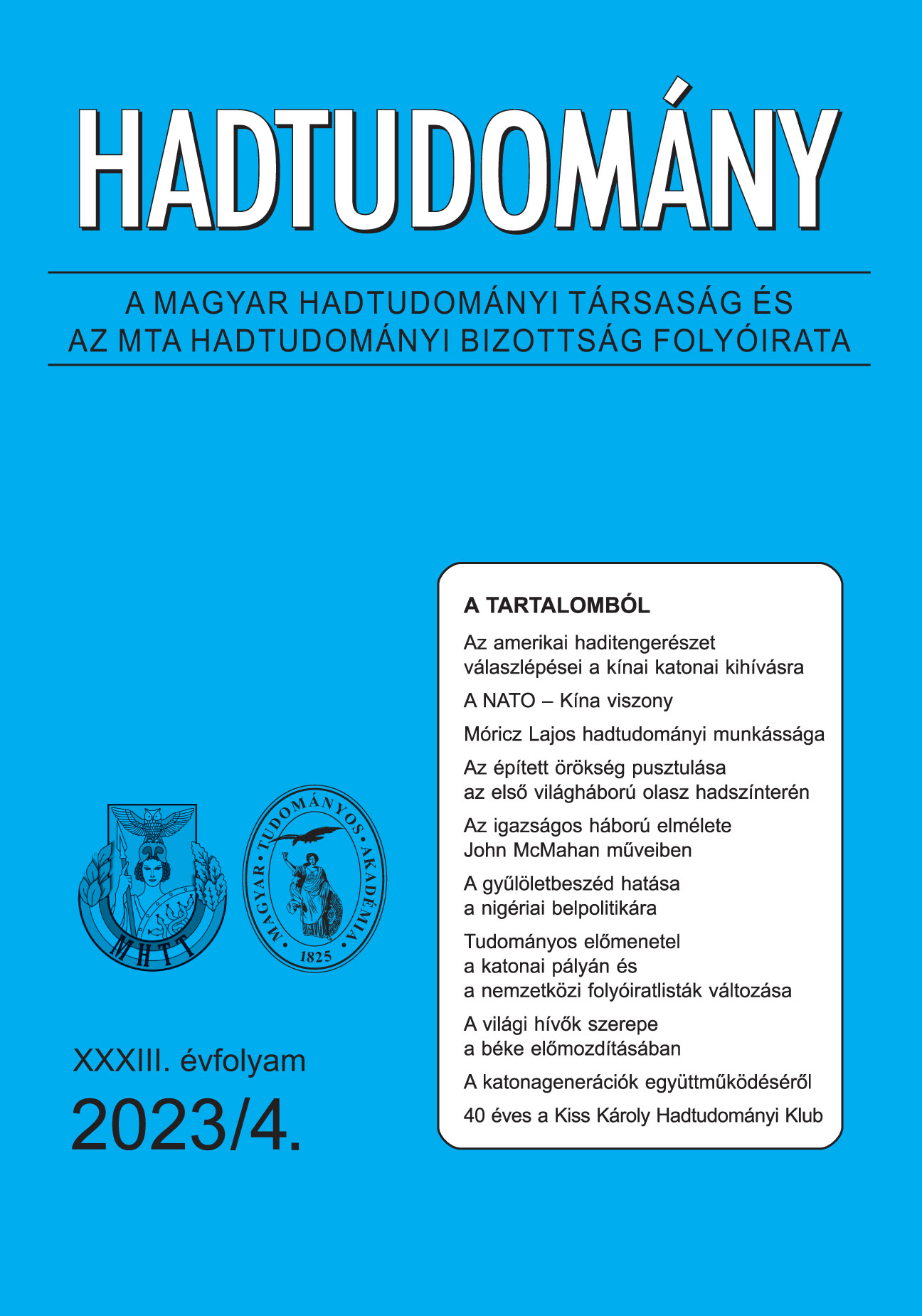A NATO Kína ellen?
Absztrakt
Kína kérdése az elmúlt években egyre hangsúlyosabban jelent meg a NATO agendáján, ugyanakkor a szervezet kapcsolata a felemelkedő keleti hatalommal a szövetségesiálláspontok megosztottsága mentén ambivalens. Tanulmányunkban azt vizsgáljuk, hogy a NATO-nak feladata-e egy kelet-ázsiai állammal foglalkozni, illetve képes lenne a szervezet fellépni egy Kínához hasonló, nem közvetlen fenyegetés ellen? A főbb nemzetközi kapcsolatok paradigmáinak bemutatását követően a tanulmányamellett érvel, hogy a strukturális realizmus keretrendszere biztosítja a legalkalmasabb szempontrendszert elméleti és gyakorlati előrejelzések vázolására. Elméleti síkon a NATO–Kína kapcsolatában addig nem várható minőségi változás, míg a szövetségesek általános fenyegetettség percepciója át nem vált specifikussá. A kohézió hiányából adódó biztonsági dilemma miatt a gyakorlatban az Amerikai Egyesült Államoknak kevés esélye van komoly, aktív szereppel „felruháznia” a NATO-t a Kína ellenes hegemóniáértfolytatott küzdelmében.
Hivatkozások
Allison, Graham 2017. Destined for War. London: Mariner.
Anderlini, Jamil and Clea Caulcutt 2023. Europe must resist pressure to become ‘America’s followers,’ says Macron. Politico, April 9, 2023. https://www.politico.eu/article/emmanuel-macron-china-america-pressure-interview/
Bechná, Zinaida, Bradley A. Thayer 2016. NATO’s New Role: The Alliance’s Response to a Rising China. Naval War College Review, 69 (3): 65–82.
Bolt, Paul J., Sharyl N. Cross 2010. The Contemporary Sino-Russian Strategic Partnership: Challenges and Opportunities for the Twenty-First Century. Asian Security, 6 (3): 191–213.
Boutilier, James Dr. 2012. Can NATO Find a Role for Itself vis-á-vis China? Research Paper NATO Defence College, 87. (2012): 1–7.
Chaban, Natalia 2017. NATO Global Perceptions – Views from the Asia-Pacific Region. Asian Security, 14 (1):1–7.
Daalder, Ivo, and James Goldgeier 2006. Global NATO. Foreign Affairs, Sept 1, 2006. https://www.foreignaffairs.com/articles/2006-09-01/global-nato
EU International Goods Statistics. Last modified 19 May 2023. https://ec.europa.eu/eurostat/statistics-explained/index.php?title=China-EU_-_international_trade_in_goods_statistics#:~:text=in%20Figure%205.-
Heisbourg, François 2020. NATO 4.0: The Atlantic Alliance and the Rise of China. Survival Global Politics and Strategy, 62 (2): 83–102.
Hendrickson R. C. 2014. The Changing Role of NATO’s Secretary General. In NATO’s Post-Cold War Politics, ed. Mayer S. 124–139. London: Palgrave Macmillan (New Security Challenges Series.)
Holslang, Jonathan 2019. China, NATO, and the pitfall of empty engagement. The Washington Quaterly, 42 (3): 137–150.
Kjeldsen, Mad and Friis Arne Petersen 2014. China and NATO: Room for Partnership? In Cooperative Security: NATO’s Partnership Policy in a Changing World ed Trine Flockhart. 87–98. Copenhagen: Danish Institute for International Studies.
Larsen, Henrik 2020. China’s Rise Can Unite NATO. ETH Zürich Research Collection. (2020): 1–4.
Mártonffy Balázs 2019. Analysis Paralysis: Threat Perception and Incohesion in NATO. Doctoral Dissertation, American University, 2019.
Mearsheimer, John J. 1990. Back to the future: Instability in Europe after the Cold War. International Security, 15 (1): 5–56.
Michaels, Jeffrey H. 2021. A very different kind of challenge? NATO’s prioritization of China in historical perspective. International Politics, 59 (6):1045–1064.
NATO Észak-Atlanti Szerződés 1949. Észak-Atlanti Szerződés. Washington, 1949. https://www.nato.int/cps/en/natohq/official_texts_17120.htm?selectedLocale=hu
NATO London Declaration 2019. London Declaration. London, 2019. https://www.nato.int/cps/en/natohq/official_texts_171584.htm
NATO Brussels Summit Communique 2021. Brussels Summit Communique. Brussels, 2021. https://www.nato.int/cps/en/natohq/news_185000.htm
NATO Strategic Concept 2022. https://www.nato.int/nato_static_fl2014/assets/pdf/2022/6/pdf/290622-strategic-concept.pdf
NATO 2030. NATO 2030: United for a New Era. 2020. https://www.nato.int/nato_static_fl2014/assets/pdf/2020/12/pdf/201201-Reflection-Group-Final-Report-Uni.pdf
NATO Update: NATO Secretary General to visit Republic of Korea and Japan. Last modified Feb 1, 2023. https://www.nato.int/cps/en/natohq/news_211016.htm
NATO Online press conference by NATO Secretary General Jens Stoltenberg following the second day of the meetings of NATO Ministers of Foreign Affairs. Last modified Dec 02, 2020. https://www.nato.int/cps/en/natohq/opinions_179796.htm
United States Department of Defense, 2022. National Defense Strategy of the United States of America. 2022. https://media.defense.gov/2022/Oct/27/2003103845/-1/-1/1/2022-NATIONAL-DEFENSE-STRATEGY-NPR-MDR.PDF
Ringsmose, Jens and Sten Rynning 2021. NATO’s Next Strategic Concept: Prioritise or Perish. Survival Global Politics and Strategy, 63 (5): 146–168.
Snyder, G. H. 1984. The Security Dilemma in Alliance Politics. World Politics, 36 (4): 461–495.
Waltz, K. N. 1993. The Emerging Structure of International Politics. International Security, 18 (2): 44–79.
Walt, S. M. 1985. Alliance Formation and the Balance of World Power. International Security, 9 (4): 3–43.
Weitsman, Patricia 2004. Dangerous Alliances: Proponents of Peace, Weapons of War. Stanford: Calif.: Stanford University Press.
Wendt, A. 2001. Driving with the Rearview Mirror: On the Rational Science of Institutional Design. International Organization, 55 (4): 1019–1049.




